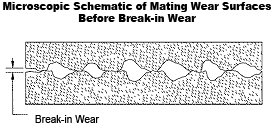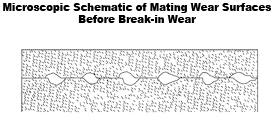Wear Mechanism
The study of wear is a field called tribology. There is much research on the subject, but little definitive work that can help determine the wear rate of two surfaces in any specific application.
The wear mechanism itself is simple to understand. With reference to Figure 38, two rubbing surfaces contact only at their highest microscopic aspersions. When the contact stress is high enough and under the relative motion, these aspersions shear off and become debris.
Lower aspersions then come into contact and the contact area increases until the unit pressure and the underlying materials shear strengths are in balance. At this point, break-in wear has occurred and the surfaces appear as in Figure 39, and can be represented by the curved line between A and B in Figure 37.
After break-in, a steady-state, continuous wear pattern begins, as represented by the straight line between points B and D in Figure 37. Unless the surfaces are completely separated with a lubricant film some wear will occur continually as the mating surfaces rub each other in normal service life.

FIGURE 38

FIGURE 39